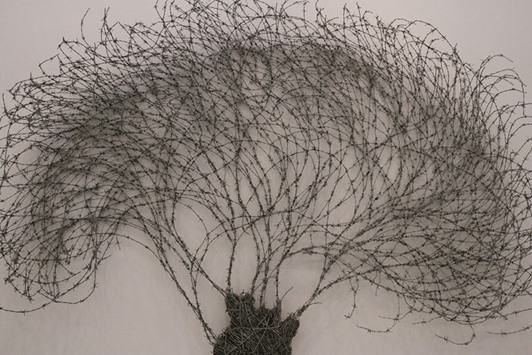His work is always unorthodox. Not just the idea, the medium he chooses to express them itself is unique. Revolving around the olive harvest in Palestine, with the olive tree symbolising Palestinian history and culture, Abdul Rahman Katanani, the 33-year-old Palestinian artist, brings out some of his masterpieces for the audience in Doha in his recent exhibition.
Currently on display at Katara Art Centre (KAC), building 5, the exhibit ‘Children, Olive Trees and Barbed Wires’ presents the risks to the tree through occupation, bulldozing and uprooting which the artist believes are like those facing the Palestinian people as they are encircled by barbed wire and dispossessed of their land.
“He lives in probably the most famous Palestinian refugee camp, the site of a massacre during the civil war. And as we all know it is a very expensive undertaking, you cannot afford canvases and brushes, so he decided to make his art from found objects that surround him in the camp so all of the children are cut out of roofing material,” Heather Alnuweiri from al Markhiya Gallery, the organisers, tells Community.
The figures are cut out of the traditional zinc roofing material in the camp and, as it is a refugee camp surrounded by barbed wire, the barbed wire figures prominently.
“He has been doing an artist residency. In the last year, I believe he was doing the lithograph but know when you think of Abdur Rahman Katanani, this is what you think of,” says Heather.
For instance in a piece with a girl in it, flowers in her hair, and the ribbon in her hair is an old Mirinda bottle. The shoes and the gold pieces are usually from an old olive oil or cheese tin.
“I know he has told me that the hat on the head of the girl comes from metal plates as a lot of times they have to eat out of metal plates. So he would take them out of his mother’s kitchen and he would cut and dye them and that metal plate becomes a hat for a child,” says the gallery’s marketing and sales manager.
Katanani was born right after the massacre in 1983 in the camp and he still lives there. He has somehow managed to acquire both his BFA and MFA in Beirut.
Heather says she personally loves the large olive tree in this exhibition.
“That is something amazing. He generally tends to work in a way that his figures are almost always children. Sometimes they might be like a whole refugee family and the reason for that is that he believes that the children are the future, as many of us do,” she adds.
Children are innocence, they are the hope, they are the dream. And just like other children, even if they are refugee children, they do the same things as do the other children. They play, and run and collect flowers and they carry their little patrimony with them like the little girl and the boy here who are carrying olive tree branches behind them.
“They will do something simple because they do not have money to have the iPad, like perhaps sack races. The olive trees are new and I think within the last one year, he has started doing the olive trees,” Heather says.
Katanani’s work would be at Christie’s auction in Dubai in April this year.
The olive tree is one of his masterpieces and it is the most expensive item on display here. The piece is priced over QR90,000.
“He is using barbed wire because it reveals to us, who know the refugee camps, the reality for these children. These are normal children like any other children and they would be normally playing on grass,” Heather explains.
“But let me tell you how much grass is there in the camp. I have actually gone to the camp and there is no grass there. So this is kind of ironic. The children who are like everybody else’s children have committed no crime and have no guilt are left to play in a barren place,” she adds.
She believes Katanani’s work is great. He is dealing with Palestinian issue but he is dealing with it in a medium that is completely new and he is dealing with it in a way that does give us hope, says Heather.

BARBED TREE: Abdul Rahman Katnani’s olive tree symbolises Palestinian history and culture. Photo by Umer Nangiana
